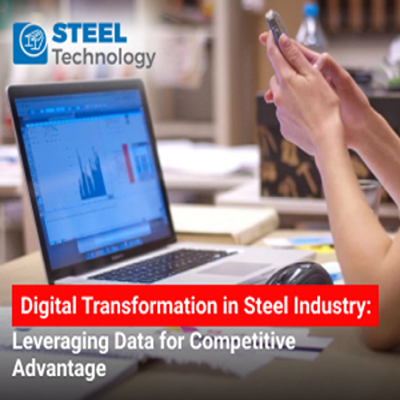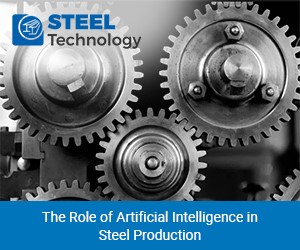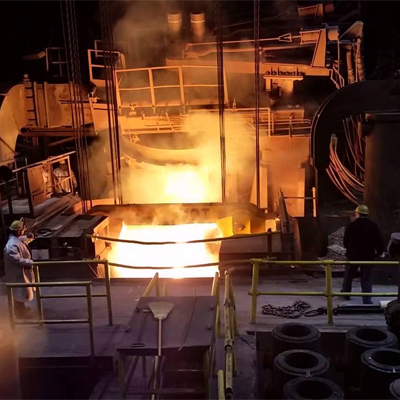Digital Transformation in Steel Industry: Leveraging Data for Competitive Advantage

The steel industry stands as an essential pillar in the global infrastructure ecosystem, serving as the backbone for construction, manufacturing, and numerous other critical sectors. From towering skyscrapers to intricate machinery, steel plays a fundamental role in shaping the modern world. However, in an era where technological advancements drive rapid progress, the steel industry must embrace digital transformation to maintain its competitive edge and meet evolving market demands.
While the industry has long been characterized by its robust physical processes and traditional manufacturing techniques, the shift towards digitalization has become imperative to streamline operations, enhance productivity, and foster innovation. In this age of interconnected systems and data-driven insights, the steel industry faces the pressing need to integrate cutting-edge technologies and leverage data to optimize every stage of production, from raw material sourcing to distribution.
Embracing digital transformation fundamentally reshapes steel production, creating unique avenues for efficient scaling, cost reduction, and the delivery of superior products. This shift not only allows the steel industry to cater to evolving market demands but also establishes a path towards sustainable growth and resilience in the face of fluctuating market trends and environmental demands. As the industry embarks on this transformative path, it underscores the imperative need to harness data and technology, emphasizing that doing so is not merely an option but a prerequisite for survival and enduring prosperity.
Understanding the Digital Transformation Landscape in the Steel Industry
The steel industry, known for its rich history and integral role in global development, has undergone a remarkable evolution over the years. From the early days of manual labor and rudimentary manufacturing processes to the advent of sophisticated machinery and automated systems, the industry has continuously adapted to meet the ever-growing demands of a rapidly changing world.
However, despite its resilience, the modern steel sector faces a plethora of challenges that necessitate a paradigm shift towards digital transformation. These challenges include escalating production costs, volatile market dynamics, stringent environmental regulations, and the need for improved operational efficiency. In an era characterized by relentless technological advancements and an increasingly interconnected global marketplace, the traditional methods of production and management have become insufficient in ensuring sustainable growth and profitability.
Digital transformation, within the context of the steel industry, represents a holistic approach to integrating advanced technologies and data-driven solutions into every aspect of the production cycle. It entails the adoption of state-of-the-art tools such as the Internet of Things (IoT), Artificial Intelligence (AI), machine learning, and big data analytics to streamline operations, enhance decision-making, and optimize resource utilization. By leveraging these technologies, the steel industry can address critical challenges and unlock a multitude of benefits and opportunities, ranging from improved process efficiency and cost reduction to enhanced product quality and customer satisfaction.
In addition, digital transformation empowers steel manufacturers to access critical insights into market trends, consumer preferences, and supply chain dynamics. This knowledge is instrumental in making informed strategic decisions, keeping them competitive. Moreover, it fosters the development of flexible and responsive production systems that can readily adapt to changing market demands, ensuring resilience in a dynamic business landscape.
In summary, digital transformation acts as a driving force for the progression of the steel industry, fostering an environment of innovation and continual advancement while cementing its position as a prominent global industrial participant. By embracing digitalization, the industry not only overcomes its existing obstacles but also capitalizes on emerging opportunities for sustainable growth and long-term prosperity.
Key Elements of Digital Transformation in the Steel Industry
The digital transformation journey within the steel industry is intricately woven with the integration of key technological elements that redefine traditional manufacturing processes and pave the way for unprecedented efficiency and innovation. Embracing advanced technologies such as the Internet of Things (IoT), Artificial Intelligence (AI), and big data analytics has become instrumental in revolutionizing the steel sector, enabling companies to make data-driven decisions and optimize their operations for enhanced productivity and competitiveness.
The Internet of Things (IoT) serves as a critical enabler in the steel industry, facilitating the seamless connectivity of various equipment, machinery, and devices within the production ecosystem. By deploying a network of interconnected sensors and smart devices, steel manufacturers can gather real-time data on crucial parameters such as temperature, pressure, and machine performance. This real-time data enables proactive maintenance, predictive analytics, and the identification of potential bottlenecks, thereby minimizing downtime and optimizing overall operational efficiency.
Artificial Intelligence (AI) plays a pivotal role in enhancing decision-making processes and automating complex tasks within the steel manufacturing workflow. Through the implementation of AI-driven algorithms and machine learning models, manufacturers can analyze vast datasets to identify patterns, predict maintenance needs, and optimize production schedules. AI-powered systems can also facilitate predictive quality control, ensuring that the produced steel meets the highest standards while minimizing defects and waste.
Big data analytics, an essential element of digital transformation, enables steel companies to extract valuable insights from the vast volumes of data generated during the production cycle. By utilizing advanced data analytics tools, manufacturers can develop a comprehensive understanding of market trends, customer preferences, and supply chain dynamics. This comprehension facilitates informed decision-making, optimized inventory management, and streamlined production planning, resulting in cost savings and enhanced resource allocation.
Moreover, the integration of these technologies cultivates a data-driven culture within the steel industry, highlighting the significance of utilizing data to propel strategic initiatives, refine product development, and enhance overall business performance. By harnessing the combined potential of IoT, AI, and big data analytics, steel manufacturers can attain a competitive edge, ensure uniform product quality, and establish a robust groundwork for sustainable growth in an ever-evolving and competitive global market.
The Impact of Data Utilization on Operational Efficiency
The utilization of data within the steel industry has significantly transformed operational efficiency, bringing about a paradigm shift in the way manufacturers monitor, manage, and optimize their production processes. By harnessing the power of data, steel companies can make informed decisions, mitigate risks, and streamline operations for maximum efficiency and productivity.
The implementation of IoT devices for real-time monitoring and predictive maintenance has emerged as a game-changer for the steel industry. By deploying a network of interconnected sensors and devices, manufacturers can continuously monitor critical equipment and machinery, ensuring that any deviations or anomalies are promptly identified. Real-time monitoring facilitates proactive maintenance interventions, preventing unexpected breakdowns and reducing downtime. Predictive maintenance further enhances operational efficiency by leveraging data-driven insights to schedule maintenance activities based on actual machine conditions, thereby optimizing maintenance costs and extending equipment lifespan.
Artificial Intelligence (AI) plays a crucial role in optimizing production processes and minimizing errors within the steel manufacturing workflow. AI-powered systems can analyze complex data sets in real-time, identifying patterns and anomalies that may impact production quality and efficiency. By integrating AI-driven solutions, manufacturers can automate tasks, enhance process control, and minimize the occurrence of errors and defects. AI also facilitates the implementation of advanced quality control measures, ensuring that the manufactured steel meets the highest standards while minimizing waste and rework.
Big data analytics has revolutionized supply chain management, inventory optimization, and demand forecasting within the steel industry. By analyzing large volumes of data related to supply chain dynamics, manufacturers can make informed decisions regarding raw material sourcing, transportation logistics, and supplier management. This insight enables optimized inventory management, reducing inventory holding costs while ensuring a steady supply of materials for uninterrupted production. Furthermore, big data analytics facilitates accurate demand forecasting, enabling manufacturers to align production schedules with market demand, thereby minimizing stockouts and surplus inventory.
The combined impact of data utilization, IoT, AI, and big data analytics on operational efficiency has transformed the steel industry's ability to optimize resource allocation, reduce costs, and streamline production processes. By leveraging these technologies, manufacturers can achieve higher productivity, improved product quality, and enhanced customer satisfaction, ultimately reinforcing their competitive advantage in the global market.
Leveraging Data for Sustainable Growth and Innovation
The steel industry's adoption of data-driven insights has not only revolutionized operational efficiency but has also paved the way for sustainable growth and innovation, positioning the industry at the forefront of environmentally conscious manufacturing practices and fostering the development of new revenue streams.
Data utilization has played a pivotal role in the development of eco-friendly manufacturing practices within the steel industry. By analyzing environmental impact data and leveraging advanced technologies, manufacturers can optimize energy consumption, reduce emissions, and minimize the industry's overall carbon footprint. Data-driven insights enable the implementation of sustainable production techniques, such as using recycled materials, adopting energy-efficient processes, and integrating renewable energy sources into the manufacturing process. These practices not only contribute to environmental conservation but also resonate with the growing demand for sustainable and eco-friendly products, thereby enhancing the industry's reputation and market competitiveness.
Furthermore, data utilization has opened avenues for the creation of new revenue streams within the steel industry. By harnessing the power of data analytics, manufacturers can identify market trends, consumer preferences, and emerging opportunities for product diversification. Leveraging these insights, steel companies can develop innovative products tailored to specific market segments, thereby expanding their product portfolios and tapping into new revenue streams. Additionally, the integration of data-driven marketing strategies enables manufacturers to target niche markets and cater to evolving customer demands, further augmenting their revenue-generating capabilities.
Digital twins, a cutting-edge technology enabled by data utilization, have emerged as a powerful tool in simulating and optimizing complex manufacturing processes within the steel industry. By creating digital replicas of physical assets and production systems, manufacturers can conduct virtual simulations, monitor performance, and identify potential inefficiencies or areas for improvement. Digital twins enable manufacturers to optimize production parameters, improve product quality, and minimize waste by facilitating real-time adjustments and predictive analysis. This proactive approach not only enhances product quality and consistency but also reduces material wastage, contributing to sustainable manufacturing practices and resource conservation.
In essence, the steel industry's utilization of data-driven insights, coupled with a focus on sustainable practices and innovation, is driving transformative growth and positioning the industry as a frontrunner in the global market. By embracing data-driven sustainable practices and leveraging emerging technologies like digital twins, the steel industry is not only ensuring its long-term viability but is also setting new standards for responsible manufacturing and environmental stewardship in the industrial landscape.
Challenges and Considerations in Implementing Digital Transformation
Despite the numerous benefits that digital transformation offers the steel industry, its successful implementation is not without challenges. Companies venturing into this transformative journey must navigate various complexities and considerations to ensure a seamless and effective transition. Some of the key challenges and considerations include cybersecurity risks, data privacy concerns, and the necessity for skilled personnel to oversee and enhance digital transformation processes.
Cybersecurity remains a primary concern in the digital era, particularly for industries handling sensitive data and proprietary information. The steel industry's integration of interconnected systems and data-driven technologies increases its vulnerability to cyber threats and potential breaches. Protecting critical data, intellectual property, and operational infrastructure from cyber-attacks requires robust cybersecurity measures, including the implementation of advanced encryption protocols, multi-layered security frameworks, and continuous monitoring systems. Companies must prioritize cybersecurity as an integral part of their digital transformation strategy to safeguard their operations and maintain stakeholder trust.
Data privacy represents another crucial aspect in the realm of digital transformation. As companies gather and scrutinize extensive volumes of data, ensuring adherence to data privacy regulations and safeguarding the secrecy of sensitive information becomes of utmost importance.
Implementing rigorous data privacy protocols, conducting periodic audits, and offering transparent consent mechanisms for data collection are imperative to instill confidence among customers and stakeholders. Companies should prioritize data privacy as a foundational element of their digital transformation endeavors, fostering a culture of ethical data practices and conscientious data administration.
Moreover, the successful implementation of digital transformation initiatives in the steel industry necessitates a workforce equipped with the necessary digital skills and expertise. Companies must invest in upskilling their employees and recruiting individuals with the requisite knowledge in data analytics, cybersecurity, and digital technologies. Training programs, workshops, and educational partnerships can help bridge the skills gap and empower employees to effectively leverage digital tools and technologies in their day-to-day operations. Cultivating a culture of continuous learning and innovation is vital to ensuring the seamless integration and optimization of digital transformation processes within the organization.
To overcome these challenges and effectively implement digital transformation strategies in the steel industry, companies should prioritize the development of a comprehensive digital roadmap, aligning technological investments with their long-term business objectives. Establishing cross-functional teams dedicated to overseeing digital transformation initiatives and fostering collaboration between IT and operational departments can facilitate the seamless integration of digital technologies into existing workflows. Regular performance assessments, feedback mechanisms, and agile project management methodologies can enable companies to adapt and refine their digital transformation strategies in response to evolving market dynamics and technological advancements.
By proactively addressing these challenges and considerations, the steel industry can optimize operational efficiency, leverage the benefits of digital transformation, and position itself for sustained growth and competitiveness in the digital age.
Conclusion:
The steel industry's transformative journey, driven by the integration of digital technologies and data-driven insights, represents a pivotal milestone in its evolution. Throughout this article, we delved into the profound impact of digital transformation on the steel industry, emphasizing its role in enhancing operational efficiency, fostering sustainable practices, and propelling innovation. Through the adoption of advanced technologies like the Internet of Things (IoT), Artificial Intelligence (AI), and big data analytics, the industry has unlocked fresh opportunities for growth, positioning itself as a trailblazer in technological innovation and sustainable manufacturing practices.
The utilization of data has completely transformed the steel manufacturing process, impacting production planning, quality control, supply chain management, and customer engagement. Real-time monitoring through IoT devices has allowed for proactive maintenance, reducing downtime, while AI-driven insights have optimized production processes, minimizing errors and improving product quality and customer satisfaction. Furthermore, big data analytics has facilitated informed decision-making, streamlined supply chain operations, and enhanced inventory management, leading to cost savings and improved resource allocation.
Furthermore, the steel industry's commitment to sustainable growth and innovation, driven by data-driven insights, has led to the development of eco-friendly manufacturing practices and the creation of new revenue streams. By leveraging digital twins, manufacturers have optimized complex manufacturing processes, improved product quality, and reduced waste, thus contributing to a more sustainable and environmentally conscious approach to production.
Looking ahead, the future prospects of digital transformation in the steel sector appear promising, with continued advancements in technology expected to further enhance operational efficiency, product innovation, and market competitiveness. As the industry continues to embrace digitalization, it is poised to drive further growth and innovation, fostering a culture of continuous improvement and adaptation to meet the ever-evolving demands of the global market. The convergence of digital technologies, sustainable practices, and a skilled workforce sets the stage for a resilient and dynamic steel industry that remains at the forefront of global industrial development in the years to come. Embracing the transformative power of digital transformation is not only crucial for maintaining competitiveness but also for shaping a more sustainable and resilient future for the steel industry and the global economy as a whole.











